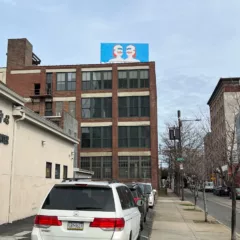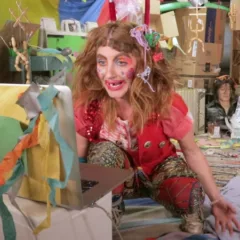Of course size matters. But here’s the question: Do works of art want to be a certain size?
Art that wants to be small
Here we have an exhibit of eighty-five small sculptures by thirty-six local artists selected by Leslie Kaufman, the president of Philadelphia Sculptors and a member of the Art In City Hall Exhibitions Advisory Committee.
Ms. Kaufman described, in her curator’s statement, the selection criteria for inclusion in the show as follows: besides for playing well with each other, each piece had to be smaller than twelve inches, and each piece had to convince her that it “wanted to be small…that its identity was tied to its diminutive stature.”
Art that wants to be small – how intriguing. But isn’t it a strange notion, one that you would probably not consider unless you were thinking about extremes of size?
I want to say that art works (or not) based upon a myriad of factors, size being only one of many. But here we have eighty-five works of art — a multiplicity of viewpoints, media and materials – that actually work well together and, for reasons that I think are idiosyncratic, want to be small.
There are far too many pieces to review, but here are a few that stood out for me.
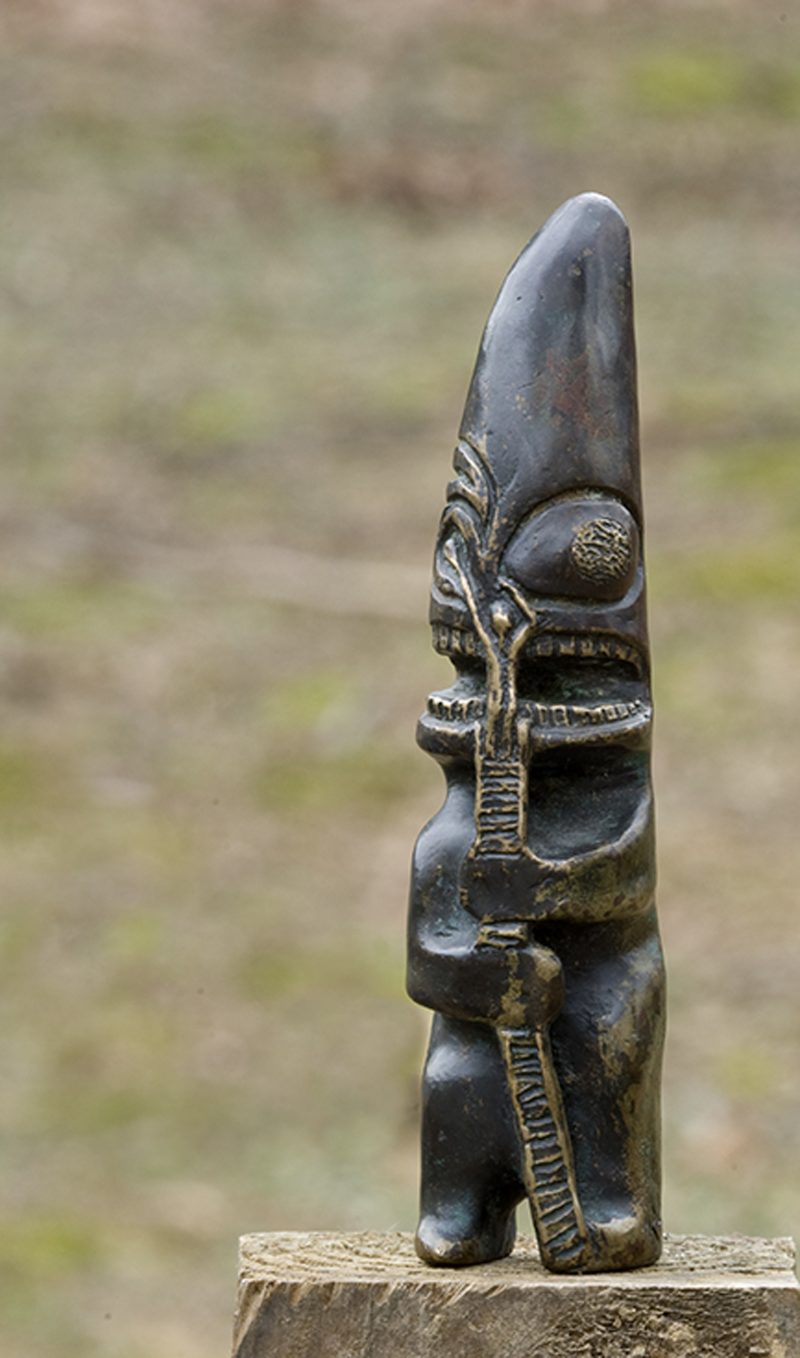
In Greenlandic Inuit tradition, shamans practiced in the art of witchcraft fabricated tupilaks out of animal, human or bird remains. Tupilaks were thought to embody sinister mythical spirits. They were dangerous, avenging monsters intended to kill their enemies.
Because they were perishable, none survived, and the Inuits later began to carve small representations of them out of wood, narwhal, walrus tusk and caribou antler, which captured their belligerence.
Remo Williams’s bronze Rai Tupilak was inspired, he told me, by a Greenlandic walrus tusk carving of a tupilak that he found in Fairbanks, Alaska during a journey he made from Mexico to the Arctic Circle in a ’54 Chevy Panel Van. The figure is 6 ¼ inches tall.
Interestingly, Williams conceived of his piece as representative of the human quest to touch the divine, to rise above the precarious intricacies of ordinary existence – thus, the human arrived at the top of the ladder being held by the perilous (and perhaps slightly crazy), godly creature.
The word RAI was inscribed on the tupilak that inspired Williams, but he explained that its meaning was unclear. He thought that it either referred to the sun, the Sun God, or to the identity of the carver.
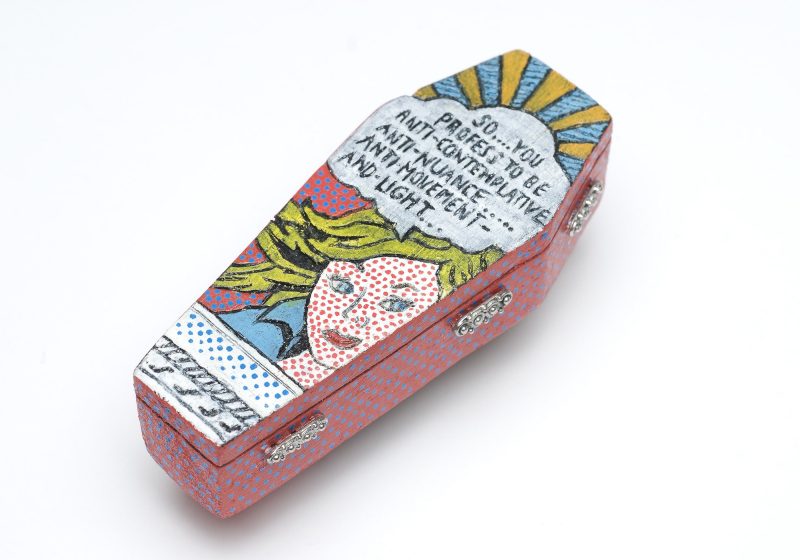
This little Roy Lichtenstein coffin is part of E. Sherman Hayman’s LATE (euphemism for dead) series, which consists of thirty similar ornamental carved sculptures of coffins commemorating various artists, inventors and renegades. Included in the show are the coffins of Andre LeNotre (the French landscape architect – Louis XIV’s gardener), Julia Child and Fred Astaire. Others in the series include Hieronymous Bosch, Picasso, Joseph Albers, Henri Rosseau and Coco Chanel. They are all part of a larger project, THE FINAL FRONTIER (Star Trek?), in which Hayman seeks to examine death through artifacts, metaphors, architecture and language.
Note the inscription on Hayman’s Lichtenstein coffin:
“SO….YOU
PROFESS TO BE
ANTI-CONTEMPLATIVE
ANTI-NUANCE…..
ANTI-MOVEMENT –
AND LIGHT…”
Lichtenstein, as you may know, famously described his work as “anti-experimental, and anti-contemplative, anti-nuance, anti-getting-away-from-the-tyranny-of-the-rectangle, anti-movement-and-light, anti-mystery, anti-paint-quality, anti-Zen, and anti all of those brilliant ideas of preceding movements which everyone understands so thoroughly.”
Because there is something delightful about the coffins, one wonders whether they further Haymen’s exploration of the way modern society treats death. But what about their size? They’re only 4 ¼ “ long.
Hayman commented in her artist statement: “The petite size of the sculptures [they fit in your hand] is meant to further enhance their ‘preciousness’ and jewel-like quality, and also highlight the lighter aspects of this weighty project.”
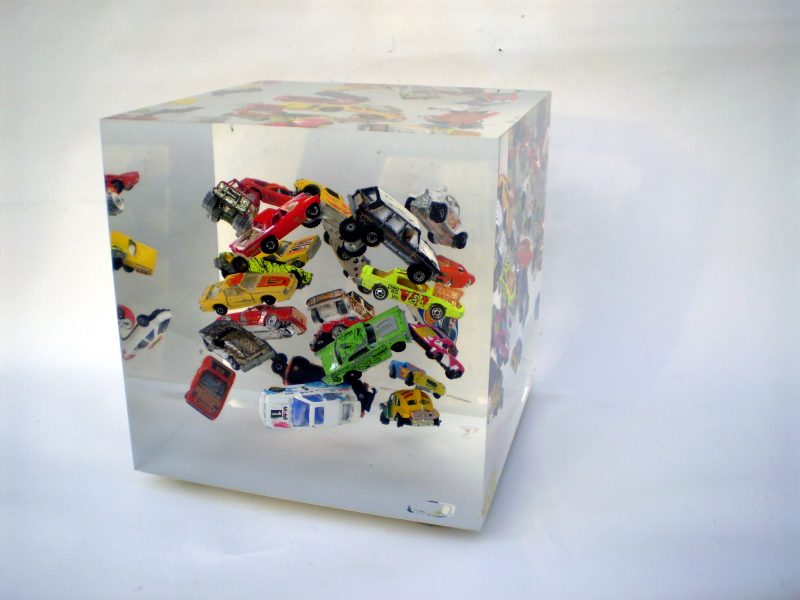
John Costanza’s wonderful ten-inch square Lucite cube embedded with floating toy cars reminded me how entrapped we have become by the automobile. I imagined its antithesis: a Lucite car entrapping a set of floating human beings. Perhaps including some toy soldiers.
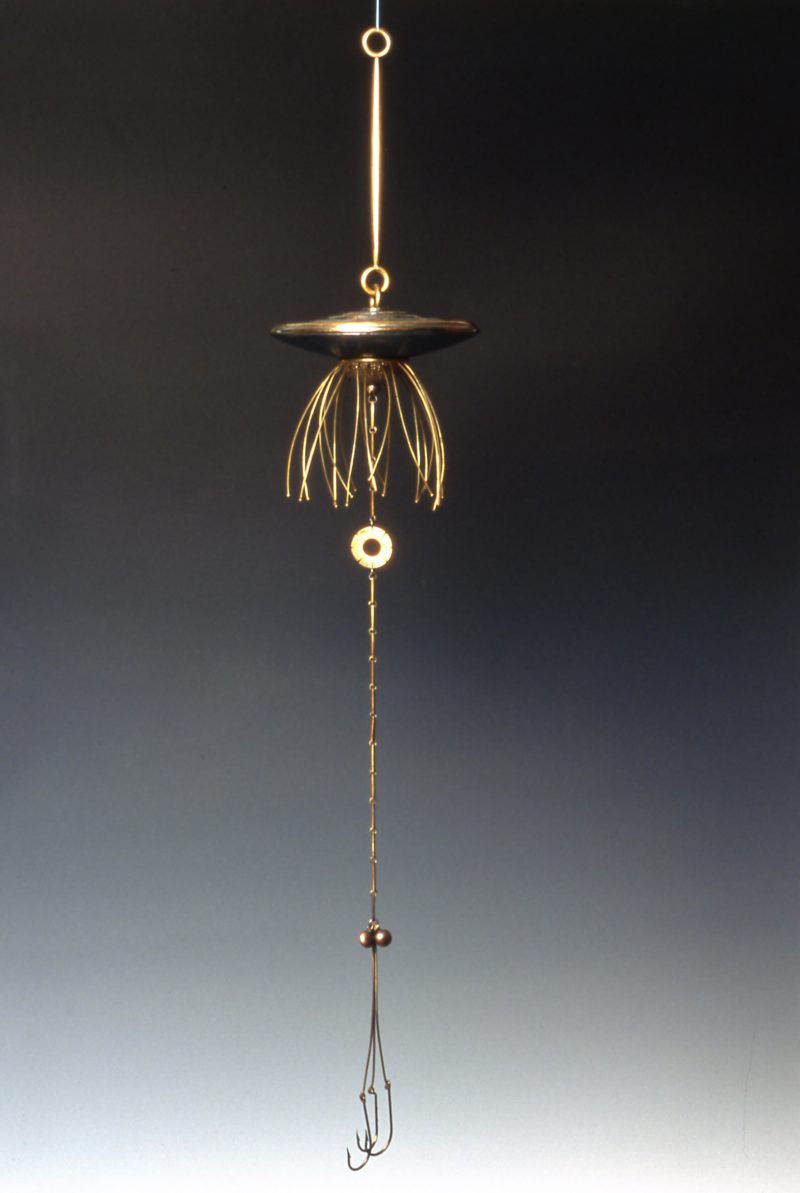
This graceful piece by Hratch Babikian – it is twelve inches from top to bottom – was inspired by the artist’s experiences fishing during childhood – thus the hooks. I actually think I would like it better without the hooks.
In his artist statement, Babikian commented: “When working on sculpture I don’t think of Size, just the appropriateness of Ratio, impact of message to viewer. My “small” sculpture is not small, it is intimate, it is personal and precious in visual information easy to miss if one is not paying attention.”
I haven’t included an image of Romaine Samworth’s “Going Bye Bye,” which is a perfectly pleasant, simple, childlike sculptural rendering of a small animal wearing a hat and scarf, constructed of yarn, paper and wire. I was surprised to learn that the artist, Romaine Samworth, is a ninety-four year old woman who lost her sight when she was eight years old. Ms. Samworth noted in her artist statement: “The smaller sculpture makes it able to view the whole piece by touch.” Well yes. And how impressive an accomplishment.
Last Words
I resist the notion that small translates to intimate and personal. And I didn’t think I would be convinced that this was an exhibition full of sculptures that want to be small, but I was. Of course there are pieces in the show that do not work for other reasons. And there are pieces that I think would also work if they were larger. But overall, it’s an appealing collection of works as to which small size clearly matters.
I actually worry about the opposite problem. About the very real encumbrances faced by art work that wants to be large.
Finally, a grateful nod to the City of Philadelphia for providing the opportunity for this large collection of local artists to display their work. It is beyond question that the well-being of the City and its citizens and guests is greatly enhanced by such promotion of the arts.
In addition to the artists discussed above, Small Sculpture includes works by Clifford Bailey, Leora Brecher, Joe Brenman, Michael Bugler, Eiko Fan, Uta Fellechner, Marguerita Hagan, Rebecca Hoenig, Lydia Hunn, Leroy Johnson, Asake Denise Jones, Karen Kieser, Neila Kun, Penelope Tsaltas Lisk, Roger Loos, Itzik Lorant, Virginia Maksymowicz, Michelle Marcuse, Heather McMordie, Michael Morgan, Howard Neifeld, Pat Owens, Carly Reed, Raymond Rorke, Colleen Rudolf, Holly Smith, Stan Smokler, Michele Tremblay, Laura Lyn Stern, Pamela Tudor, and Ted Warchal.
The exhibition “Small Sculpture” will be on display in the Art Gallery at City Hall (Room 116) to March 3, 2017.


